He’s tough to bridle, skittish about having his face handled, and forget clipping his ears or bridlepath. Even with a twitch, you’re in for a fight. The headshy horse can pose a danger to himself and to his handler.
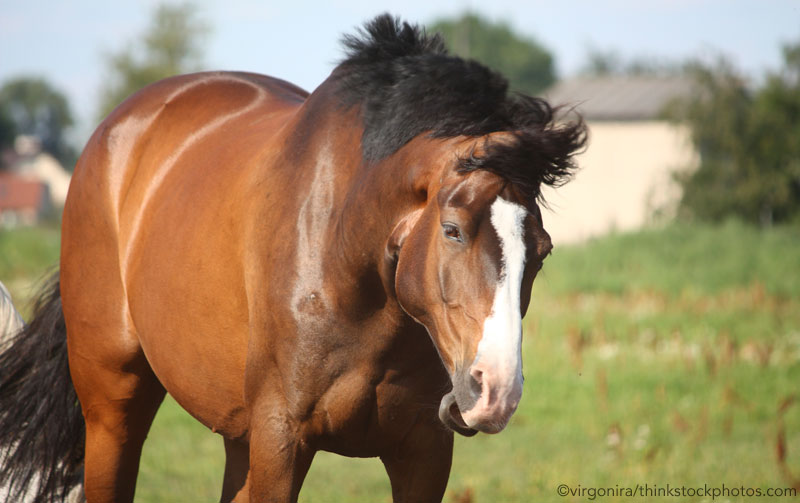
Finding the Cause
True, some cases of headshyness can be caused by physical problems, such as ear infections, mites, ear warts, jaw or tooth pain, poor eyesight or blindness in one eye, even a poorly fitting bridle. But these are not the usual culprits.
“I think the majority of headshyness is caused by sudden and aggressive movement on the human’s part toward the horse’s head,” says trainer and clinician Ken McNabb.
“Bad handling is the most obvious cause,” agrees longtime dressage competitor, trainer and coach Lendon Gray, “whether handlers lose their tempers and become abusive, or through ignorance do things that frighten and/or injure the horse.”
When headshyness is caused by a physical problem, overcoming it is easier than when it is caused by abuse or bad handling. The first step is to consult with your veterinarian to identify and treat the problem. You will still need to handle the horse with care, but once the physical symptoms are gone, the headshyness often disappears as well.
If the headshyness is caused by bad handling, you’re in for a longer journey.
Time & Patience
To overcome headshyness, your job is to regain the horse’s trust, and this can take a long time. “Time and patience are the biggest healers,” Lendon Gray says. “So much of it is spending time with the horse and using common sense when you handle him.”
Lendon has had great success working with headshy horses when they are distracted by something that gives them pleasure, such as eating. She spends time in the stall while the horse is eating and quietly begins rubbing his head. While she’s rubbing the areas where the horse is sensitive, Lendon likes to talk. “I use my voice all the time; I’m convinced it helps. It isn’t what you say, but the way you say it. You can recite the Constitution if you want; it’s the tone and your voice level that matter. You should always sound soothing, pleasant and reassuring.” It may take numerous sessions for the horse to accept this touching without trying to move his head away. (This method is not recommended with horses that are protective of their food.)
Lendon often uses massage techniques, such as those recommended by Linda Tellington-Jones, to encourage the horse to lower his head. Pressure on the hollow spot of the horse’s belly (midline) just in front of the girth area can also prompt a horse to lower his head. Often a bag of carrots and plenty of time are effective in teaching the horse to put his head down and allowing you to touch him.
“Nothing is going to work if the horse doesn’t have confidence, and thattakes time,” Lendon emphasizes. “You want the problem to go away because the horse gains confidence, not because he develops a fear that something else is going to happen to him.”
As you are building the horse’s confidence, you still have to halter and bridle him, so you need to take care not to damage what progress you’ve made. You may need to take the headstall apart for a while to bridle him until you can slip it over his ears without difficulty. If slipping the halter over his head causes a negative reaction, cup your hand over his eye until he doesn’t react. If you can’t easily reach the horse’s head, stand on something solid, such as a sturdy mounting block, until he gains enough trust and confidence to willingly lower his head.
Training for Success
Anything that forcibly restricts the horse’s movement is not a solution for overcoming headshyness and will not improve the situation. For example, if you are trying to clip the horse’s ears and he keeps moving, jerking on the lead rope will only make him more afraid of what you’re doing. The goal is to teach the horse to restrict his own movement.
“Instead of pulling on the rope, pick a part of the horse’s body and ask him to move it,” Ken McNabb says. “I may move his body forward and ask him to longe several circles around me. While he’s doing this, he’s not concentrating on the clippers or the fear of something attacking his head. Now he’s thinking, ‘How can I stop working?’ ”
Remember that you’re dealing with an animal that has the mentality of a 5-year-old child,” trainer and clinician Ken McNabb says. “When you have a frightened 5-year-old child, yelling at him and telling him to ‘quit being scared’ doesn’t do one thing to help comfort him or help him control his fear. It only raises his anxiety level. Likewise, if you start jerking on the lead rope or reins, the horse has no concept of why you are doing that.”
After a few minutes, offer the horse the opportunity to stand still for clipping. If he still reacts negatively, go back to longeing in circles. You are setting up a scenario for the horse to learn and accept what you’re doing, not an opportunity to become more afraid and just “survive” what you’re doing. You want to remove the desire to jerk his head away and instill a desire to stand there while you work with him. You do this by continually setting up a situation where you ask the horse to move his body and focus on a training exercise. However, take care not to longe the horse to the point of exhaustion.
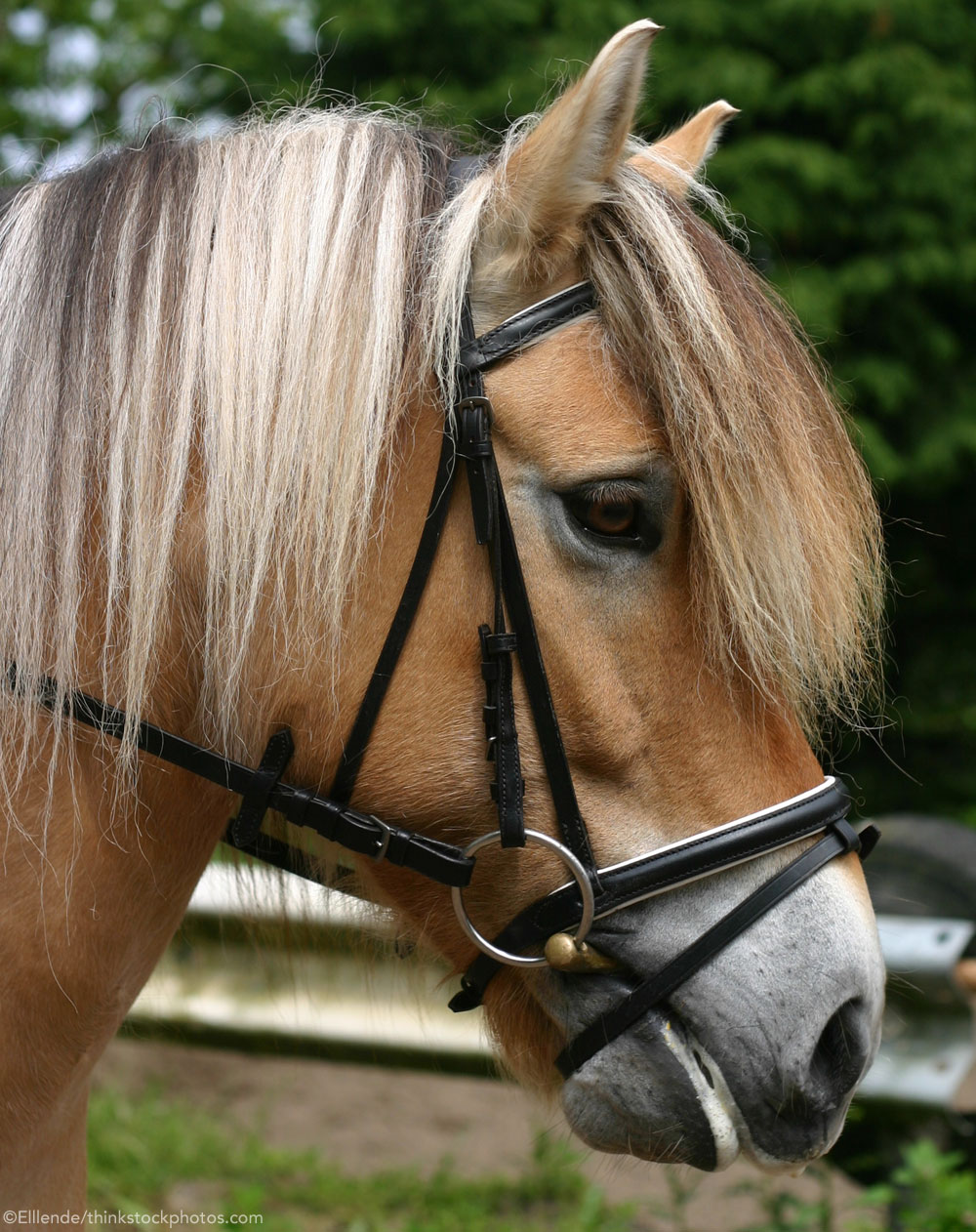
Head Handling Exercise
When it comes to handling the headshy horse, Ken uses a simple, but effective technique. With the horse in a halter, begin rubbing all over his head to discover where he is most sensitive. Once you discover the problem area, you want to focus on being able to handle that area.
Don’t tie the horse. Just hold the lead rope in one hand, and with your free hand begin rubbing and petting. Start in an area he is comfortable with and move gradually toward the sensitive area, often theears or poll. The secret is to retreat every time you make a little progress. This will build the horse’s trust and confidence.
Even if your goal is to be able to easily handle the ears, you can’t start there. Begin rubbing his lower face and gradually work upward. Every time you are able to move your hand closer to the ears, move your hand away for a moment before continuing. This keeps the horse’s anxiety from building as it would with constant touching.
“Each time I raise my hand I want to approach a little closer to his ears,” Ken notes. “I keep backing off and then moving forward until I can finally pet him all the way up to the base of his ears without him moving his head away. I then begin going past his ears, rubbing from his forehead to poll, passing over his ears and lightly touching them on the way. This motion should be rapid. I don’t want my hand to ‘stall out’ on his ears because I want to move from his ears before he has time to become afraid. I then continue this motion, but start slowing my hand down until I can slowly run my hand over his ears and move them back and forth without him becoming fearful.”
Once the horse willingly lets you handle his ears this way, you can teach him to lower his head. With your left hand on the bridge of his nose to steady his head, place your right forearm on the top of his neck so that your right hand is resting on his poll.
Exert gentle pressure with both hands until the horse begins to lower his head. Without removing your hands, immediately release this pressure once the horse drops his head at all, even if it is not much. This immediate release of pressure teaches him he’s safe and is not going to be forced to put his head down.
Continue exerting pressure and releasing until the horse learns to “give” to the pressure and lowers his head to around your waist level. At this point you can introduce the bridle, but for the first several times you should do this without a bit. You don’t want anything to bump his mouth or teeth. Your goal is simply to be able to move the headstall back and forth over his ears. Don’t attach the bit until the horse is totally comfortable with “bitless” bridling.
The amount of time it takes to achieve this varies from horse to horse. You can break this exercise into two or three sessions, but Ken prefers to do it all in one session, providing the horse is accepting each step well. Your goal is always to have the horse acting better when you stop than when you started the session. If you are running out of time and need to stop for the day, be sure to quit at a point where the horse is improving.
It helps to talk to your horse in an even, pleasant voice throughout the session. Horses are experts at reading emotions and intent. If they pick up on your frustration, they will immediately become afraid, so stay calm and always end on a positive note, Ken urges.
Getting in a hurry is the kiss of death, Lendon Gray adds. “If you don’t have enough time, don’t work with your horse that day, or you’ll regret it in the long run.” If you get careless or in a hurry even after making some progress, the situation will regress. As prey animals, horses tend to remember the bad over the good; the survival instinct remains strong, even in the domesticated horse.
What Doesn’t Work
Both Gray and McNabb agree there are a variety of things that don’t help a horse overcome headshyness, even though many owners resort to such methods. Here’s what doesn’t work:
- Jerking or pulling down on the lead rope or reins.
- Yelling at the horse. >
- Any form of punishment.
- Losing your temper or becoming frustrated.
- Being in a hurry.
- Tying the horse close to a post to bridle him. This will only teach the horse to become more frightened and pull back.
- Closely restricting the horse’s movement when he is frightened so that he can’t get away.
Avoiding Headshyness
If your horse doesn’t have a problem with headshyness, keep this from becoming an issue by always handling him with care and sensitivity.
“We’re supposed to be smarter than our horses, so we need to be aware and consciously think of what could happen,” Lendon notes. “Don’t put your horse in a situation where he’s going to become startled and bang his head. I see this all too often during trailer loading when the horse starts to back out, and the handler pulls down hard on the lead rope. The horse lifts his lead to avoid it and bangs his head on the trailer.”
Common horse handling routines, such as tying and bridling, can contribute to headshyness, so make sure you’re doing them properly.
“When you’re tying a horse, always put him in a place with plenty of room and tie with a quick release so that if something does happen and he pulls back, you can get him loose without injury,” Lendon advises.
Many headshyness problems are caused by careless, quick unbridling in which the bit hits the horse’s teeth. Always take care when removing the bridle. Slip the crownpiece over the ears slowly and hold the bridle until the horse drops or “spits out” the bit. Then remove the bridle completely.
Ideal bridling and unbridling is when the horse holds his muzzle at the level of your waist and calmly allows you to slip the headstall over his ears. If at any time he doesn’t willingly accept this, you should back up and repeat the above head-handling exercises until he does.
“The incredible thing about the horse is that he learns to forgive all past transgressions, as soon as we show him the situation is no longer dangerous,” Ken McNabb says.
Even extremely headshy horses can overcome this problem with time, patience and proper handling.
This article was featured in Horse Illustrated – July 2006 Subscribe today!

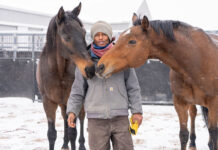
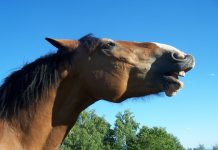
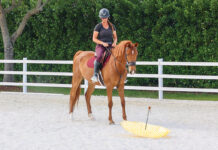
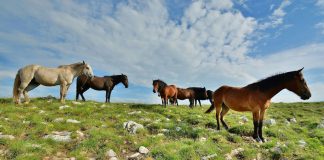


Wow, this is great. My horse is head shy but he’s funny about it. If he knows your doing something(putting the bridle on) he’s fine but if you’re just touching him, he puts his head up and refuses to be touched. Thanks this will help.
Ken McNabb is also on RFD. I no longer get this channel (due to cost) but he is one of the outstanding clinician’s on this channel. He uses the resistance free,its more dificult for you to do what you want and easier to do what I want, approach. The lunging is what I’ve always used or disengaging the hindquarters…the “what can I do to stop all this work” approach. It seems to get through to them the quickest. However, having said that, every horse is diferent right along with every situation and cause..patience #1 as was stated and consistency, with repetition..they will get it..Thankyou for having McNabb and the other outstanding trainers in your horsechannel..This articule was awesome..so are the cliencians that you have had give advice. I have seen so many people mishandle their horses and mainly because they are frustrated, which they pass on to the horse…Education!SO important! I refer your site to all of my “wanta be” horse friends ( and of course with my advise). I love the resistence free training..it produces a secure and trusting horse…Thankyou!!! Keep up the Educating.. I too learn from it..we never stop learning
Thank you once again, the more I read, the more I
understand. This paint has been mishandled, had a hard life for her first 2 years of her life . With your helpfull articals like this one hopefully I can give her a better 20 years.
thank you for this article!
Thanks! I have a shetland pony, and she will not let anyone touch her ears for anything. She freaks like she is about to die. Were not expecting that, when we got her her ears were clipped clean.
My horse is only head shy when he is intending to bite.
thanx for a very interesting and helpful article!!! my mini, Acorn, must have had his ears twitched before we had him, or handled badly, cause he doesn’t want anybody near his ears-i need to work with him more!!
when i was 12 my aunt gave me a arab mare and she had been severly mishandled, and my mother had two Trainers quit and give up on my angery lil mare,whom when you tryed to touch her face or ears bit kicked and whould rear up and trow herslef backwards,her savor was round pen work lots and lots of free lougeing and join up traning one on one with me . they must trust you soo plz plz dont used ear twiches they are painful and only mask bad horsemanship .needless to say im now 21 and to this day my mare is happy safe and the best teacher iv ever had.